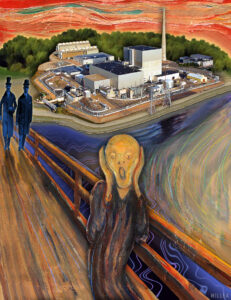 BY JOHN LAFORGE
BY JOHN LAFORGE
Xcel Energy’s Monticello nuclear reactor on the Mississippi River has leaked some 829,000 gallons of wastewater contaminated with radioactive tritium into the groundwater under its property, more than double the 400,000 gallons it first estimated. The company has since replaced two leaking pipes, built an underground retaining wall, and is cleaning up after a second spill and its temporary reactor shutdown. Yet according to WCCO TV, for July 20, 2023, Xcel has said that a “small amount of leaked water may have reached the Mississippi River.”
On March 18, 2023, the Associated Press (AP) reported that a representative of the U.S. Nuclear Regulatory Commission (NRC) told them that the tritium-contaminated wastewater from the reactor couldn’t contaminate the water people drink. The reporters quoted NRC spokesperson Victoria Mitlyng, writing: “Mitlyng said there is no pathway for the tritium to get into drinking water.”
In fact, there are two pathways for the tritium leak to get into drinking water. First, the tritium in the 829,000-gallon leak is now in a groundwater “plume” that can move beyond Xcel’s property and reach private or public drinking water wells. Second, the groundwater plume, which moves toward the Mississippi, will contaminate the river which supplies drinking water to one million-plus people in the Twin Cities and their suburbs.
Perhaps Mitlyng was misquoted, since the NRC and the AP have both reported that the plume of tritium-contaminated groundwater can move outside Xcel’s boundary. In fact, both agencies have reported that Xcel’s stated purpose in hastily building an underground steel wall between the reactor and the Mississippi is to prevent the radioactive groundwater from entering the river.
The AP reported on March 24, 2023, that Chris Clark, the president of Xcel Energy, acknowledged that the radioactive pollution can reach the Mississippi. The AP reported: “Even if the tritium reached the river, which Clark assured wouldn’t happen, it would dissipate within a few yards.” Clark’s assurance is either a mistake or a deliberate fib, because “dissipate” means to disappear, vanish, dissolve or melt away. However, tritium contamination in water lasts 123 years, that is, 10 of tritium’s 12.3-year radioactive “half-lives.” Further, there is no way to remove tritium from water once it’s contaminated — as the 1.5 million tons of tritiated wastewater being pumped into the Pacific Ocean from the 3-reactor earthquake/tsunami/meltdown site at Fukushima is showing.
Why is Xcel’s tritium in the groundwater and the great river such a threat to the people and animals that rely on it? As the NRC says, “This is because tritium travels as a form of water through the soil faster than other radionuclides.”
The city of Minneapolis proudly declares, “Our water comes from the Mississippi River. Roughly 21 billion gallons of water are pumped from the river each year, and 57 million gallons of drinking water delivered every day.”
We can’t say, “There’s nothing we can do.” Everyone can comment to the government regarding the risks posed by Monticello’s operations, when Xcel issues (any day now) its draft environmental impact statement regarding the firm’s request to extend its license and run the 54-year-old reactor until 2050, when it will turn 80.
John LaForge is a longtime co-director of the nuclear watchdog group Nukewatch, in northwest Wisconsin, and has edited its newsletter since 1992.
























